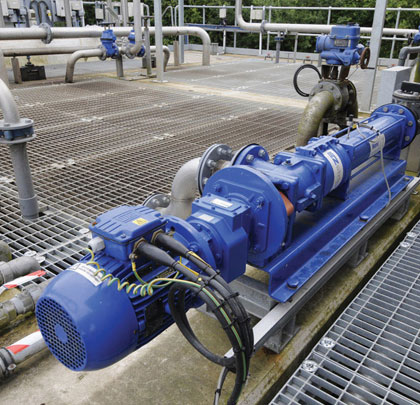With maintenance budgets dwindling but the wastewater industry being pushed to achieve ever-higher treatment standards, the pressure to find time and cost savings continues to grow. The diminishing availability of in-house expertise—and unsuitable items finding their way into the sewers—simply add to that pressure. But as a recent project in Demark illustrates, there are innovative solutions to be found that can deliver those savings.
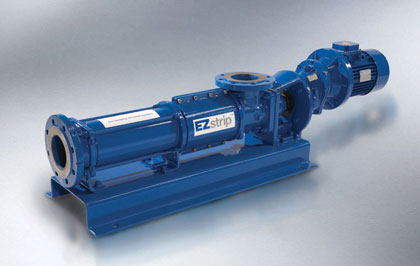
When Monoflo began the process of designing the EZstrip technology, its first step was to survey its customers in the wastewater industry to find out what common problems existed.
POPULAR BUT NOT PERFECT
When sourcing pumps for use on a new sludge dewatering process at a wastewater treatment plant at Odense in Southern Denmark, the plant’s maintenance engineers considered a progressing cavity pump as a possible solution. The progressing cavity pump has a reputation for being able to transfer difficult media easily and efficiently, including liquids with solids in suspension or with entrained gases.
This has made the progressing cavity pump a popular solution for wastewater applications, as it is generally able to cope with these difficult tasks, transferring anything from raw sewage to thickened sludges and sludge cake. However, a progressing cavity pump may need to be protected by the use of screens and grinders. Although this can be a good solution, maintenance requirements can mean that it is not always the perfect answer.
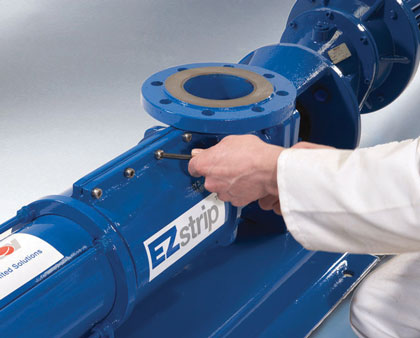
By removing a few screws, the suction chamber is easily dismantled, giving access to remove any rag build-up.
A MAJOR STEP FORWARD
Seeking a solution to their needs, the Odense engineers opted for eight EZstripTM cake pumps and sixteen Compact C Range progressing cavity pumps, from NOV Monoflo, with maintenance requirements representing a key element in their decision.
Together with the speed of delivery, their choice was based on the reduction in maintenance time that the pumps offer. NOV Monoflo’s EZstrip technology represents a major advance in progressing cavity pump design and delivers significant improvements in the time taken for maintenance operations. By simply removing a few screws, the suction chamber is rapidly and easily dismantled, giving access to remove any rag build-up or replace parts, without disconnecting either the suction or discharge pipework. This can cut the time needed to replace a rotor, stator, coupling rod, and drive train by up to 95 percent, reducing the typical day-long maintenance operation down to just thirty minutes.
“When we were invited to tender for pumps on the sludge dewatering process, we took an EZstrip demonstration pump to the plant,” explains product manager Michael Roug, from AxFlow A/S, NOV Monoflo’s distributor in Denmark who supplied the pumps. “We explained how the pump could be disassembled, de-ragged, and maintained in-situ, all in a fraction of the time which that process takes with a normal progressing cavity pump. Coupled with the fact that NOV Monoflo was also very competitive in terms of cost and speed of delivery, this made it an easy decision for the maintenance engineers. The pumps were ordered in a variety of sizes for use on different parts of the dewatering process.”

The split design of the suction chamber makes accessing a blockage simple.
BUILT AS A SOLUTION
When NOV Monoflo began the process of designing the EZstrip technology, its first step was to survey its customers in the wastewater industry to find out what common problems they faced. The overriding response was that ragging had become a serious problem and was increasing in severity to the point where it was causing serious disruption to the efficiency of treatment processes.
Progressing cavity pumps can generally cope with low levels of rag much better than most other types of pump, and depending on the application, maintenance intervals are typically long. However, higher rag concentrations can still cause blockages, especially when fibrous material becomes wrapped around the rotating shaft.
A blockage at the inlet can rapidly cause damage to the rotor, stator, and drive train, so it is imperative that this is dealt with promptly, especially as the problem is often only noticed when the flow stops and the protective electrical relays trip out. The maintenance engineer will typically then try to free up the suction chamber by removing the rag elements but dismantling as little of the pump as possible. This can lead to dangerous practices, such as inserting a sharp blade through the inlet flange and cutting away at the wound-on rag, before trying to retrieve the pieces.
Unsurprisingly, this approach often fails. The alternative is to dismantle the pump by unbolting the inlet and delivery flanges and possibly removing a section of pipe-work to give the necessary dismantling space. Removing the stator would also require space so that it could be withdrawn along the length of the rotor, especially with larger pumps. Up to 50 percent of the length of the pump might be needed as free space to allow this. The rotor would then need to be uncoupled, and depending on the extent of the ragging, the suction chamber might also need to be removed from the drive train. The drive train itself might require attention and the electrical connections would need to be isolated for that work. Even for a highly experienced maintenance engineer, this process could take up to a day, with the actual job of cleaning out the blockage representing just a fraction of the overall work required.
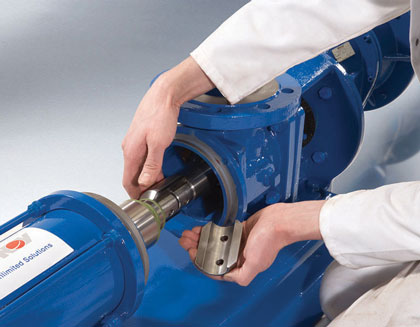
The split sleeve can be removed quickly and easily.
A NEW APPROACH
NOV Monoflo’s solution was to completely rethink the design of the suction chamber and drive train. The resulting chamber of the EZstrip pumps has a two-piece design, which can be dismantled and assembled in place, quickly and easily, using nothing more than a spanner and an Allen key. The EZstrip coupling rod can be accessed in less than one minute, the suction chamber and rotating parts deragged, and the chamber reassembled. Depending on the severity of the blockage, the whole operation can be completed in less than two and a half minutes.
For a full maintenance-in-place procedure, all rotating parts can be removed and replaced in under three and a half minutes, and a drive train can be dispatched from NOV Monoflo as an assembled unit, which eliminates the need for a skilled assembly engineer on site. The ability to leave the suction and discharge pipework connected minimizes the need for pressure testing, and also reduces the likelihood of any leakage. Where space is at a premium, eliminating the requirement for the stator dismantling space can be a great bonus, as can the ability to leave electrical connections intact.
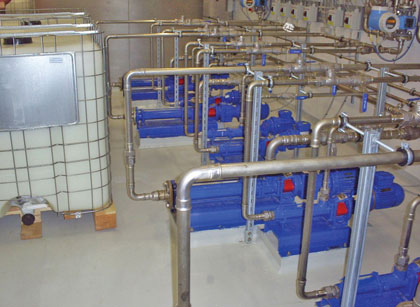
The NOV Monoflo EZstrip units installed at the Odense treatment plant.
“The Odense plant engineers were sufficiently impressed with the NOV Monoflo pumps to specify them for the sludge dewatering application,” adds Michael Roug. “However, they also ordered additional units for use on a new polymer dosing line that was being ordered for the plant.
“The manufacturer normally uses pumps from another supplier for this type of equipment, but these were changed to the NOV Monoflo pumps, again on the basis of the many advantages they offered. This resulted in a further order for two additional EZstrip pumps and two Compact C pumps.” ■
_________________________________________________________________________
ABOUT THE AUTHOR
Simon Lambert is the NOV Monoflo’s group sales and marketing director. For more information on NOV Monoflo pumps and associated equipment please visit www.monoflo.com.
_________________________________________________________________________
MODERN PUMPING TODAY, March 2013
Did you enjoy this article?
Subscribe to the FREE Digital Edition of Modern Pumping Today Magazine!
![]()


